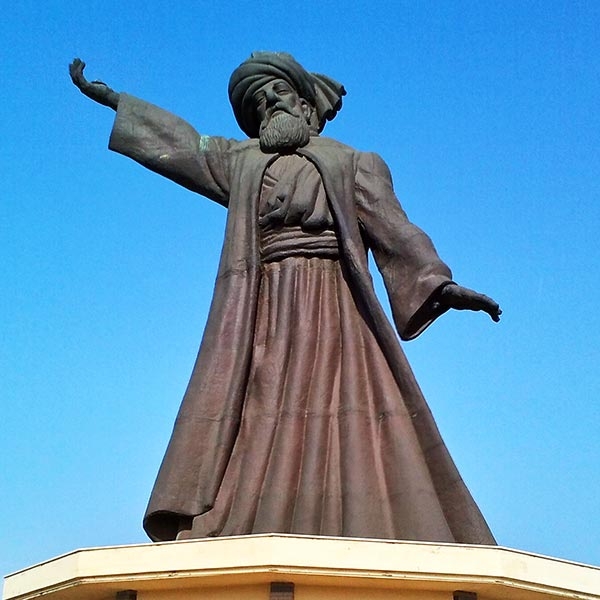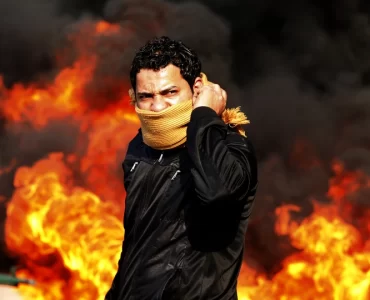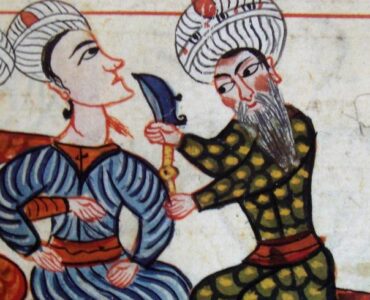
Mevlevî
The Mevlevî, a Turkish/Ottoman Ṣūfī order known also by its Arabic name Mawlawīyah, takes its name from the epithet of its founder Muḥammad Jalāl al-Dīn Rūmī (1207–1273). He was the son of the famed scholar Bahāʿ al-Dīn Valad, and migrated as a child with his father from Balkh (in modern Afghanistan) to Konya in Rum (the Seljuk Sultanate in Anatolia). The officials of Rum welcomed Bahāʿ al-Dīn and gave him the post of professor (müderris) in an institution of Islamic learning. In his early twenties Jalāl al-Dīn succeeded his father as teacher. The title Mevlâna (Arabic, mawlānā, our master) by which Rūmī became known to later generations betokens his brilliance not only in emulating his father but in surpassing him in the exposition of the spiritual and esoteric teachings of Islam. In contrast with the legalistic Islamic thinkers of his time, Rūmī was able through his poetic treatment of mysticism to attract a wider and more permanent audience. He also laid the foundations for an Islamic humanism that endured until the secularization of learning in twentieth-century Turkey. Rūmī’s elaboration of the mystical “path of love” has attracted Muslims in modern Turkey and Iran and has also stirred interest in the West. His works, including the Dīvān (Collected Poems), the Maѕ-navī (Rhyming Couplets), and the Fīhi mā fīhi (In It What’s In It, i.e., It Is What It Is), have been translated from the original Persian into Turkish and Western European languages.
The disciples of Mevlana became organized during the time of Rūmī’s son Sulṭā Valad (d. 1312). The order, that of the Mevlevî dervishes, spread through Anatolia and other parts of the Ottoman Empire. All Mevlevî lodges (tekke) were responsible to a çelebi who resided in Konya and was chosen from among Mevlâna’s descendants. The influence of the order grew in spite of the ʿulamāʿ’s interdiction of the teaching of Persian — the language of Rūmī’s poetry — in madras[{‘ahs (Islamic schools). The Mevlevîs’ influence attracted the attention of the Ottoman government, which was suspicious of potential rivals to the state. Only with the government’s control of the pious foundations that provided the income of the order was the situation stabilized.
Another aspect of the Mevlevîs’ political role was their attempt to achieve influence in palace circles beginning in the seventeenth century. They seem finally to have secured this role during the nineteenth century, when they figured as “those who gird on the sword” at the enthronements of the of Ottoman sultans. In these years they received the support of Sultan Abdülmecid (r. 1839–1861) and (with some caution) of Sultan Abdülhamid II (r. 1876–1876) and Sultan Mehmed V (r. 1909–1918). Mevlevî lodges acted as cultural centers in Ottoman cities and were a key influence in the development of Ottoman upper-class culture. Some Mevlevî leaders are known to have been sympathetic to the Young Turks. Along with all other religious orders, they were disbanded in Turkey in 1925.
The Mevlevîs became well known to Europeans through their unorthodox use of music and dance — a feature they shared with the Bektāshī order — thus acquiring the name “whirling dervishes.” Although the lodges were closed after 1925, their ceremonial practices were allowed again after 1950, and a yearly Mevlevî celebration now takes place in Konya. The attendance of a much wider audience at these tourist-oriented performances may not lower the quality of Mevlevî ceremonies, but it certainly detracts from their original mystical substance.
Rumi (1207-1273 Sufi)
Poet And Visionary

Mevlana
Jalaluddin
Rumi
Jalal al-Din Rumi is best known for his mystical poetry and his influence on the Mawlawiyah, a Sufi order founded after his death. Muslims often refer to the Mawlawiyah as the Whirling Dervishes because of their distinctive meditative dance, a ritual based on movements Rumi performed while reading his poetry. Rumi had a profound influence on philosophy and culture in Iran, Central Asia, India, and especially Turkey.
The son of a well-known religious scholar in the city of Balkh (in Afghanistan), Rumi moved at the age of 12 with his family to escape from approaching Mongols. Rumi’s family eventually settled in the city of Konya (in present-day Turkey). His father served as a legal scholar, judge, and teacher at a local madrasah (Islamic school), a position that Rumi took over after his father died. Rumi learned about Sufi mysticism from one his father’s former pupils, Burhan al-Din al-Tirmidhi. He later traveled to Syria, where he may have met the leading Islamic thinker of the time, Ibn al-Arabi.
In 1244 Rumi met a wandering holy man and mystic named Shams. Shams made an overwhelming impression on Rumi, and the two developed a close friendship that worried Rumi’s family. Bitter at Rumi’s neglect, his family and disciples forced Shams to leave town. Rumi rushed after him and begged him to return, but soon after, Shams vanished entirely. Scholars have recently confirmed that Rumi’s disciples and his son, Sultan Walad, conspired to murder Shams, burying him close to a well in Konya. The loss of Shams caused Rumi great grief, which he expressed in a major work of poetry. Called the Divan-i Shams-i Tabrizi (Collected Poetry of Shams), it displays the different stages of Rumi’s love, culminating in Rumi’s discovery of Shams within himself, “radiant like the moon.” Rumi often read these verses while performing a whirling dance that became the hallmark of the Whirling Dervishes. Some scholars believe that he also composed his poems in a trancelike state, listening to flutes, drums, the hammering of goldsmiths, or the sound of the water mill in the countryside.
Several years later, Rumi met an illiterate goldsmith named Salah al-Din Zarkub. Once again, Rumi formed a special bond that inspired him to write poetry. Rumi’s experiences with Zarkub and later with one of his disciples inspired him to write the Masnavi. The longest mystical poem ever written, the Masnavi discusses many aspects of Sufi philosophy, including religion, ethics, and metaphysics. The poem explores the relationship between the spiritual and the secular, focusing on relationships between human beings as well as the relationship between humans and Allah.
Rumi died shortly after completing the Masnavi. Along with his longer texts, he left several smaller works of poetry and prose. He enjoyed great popularity and influence among his peers, and his son Sultan Walad later formed the Mawlawiyah out of his followers. The name of the order derives from Mawlana (Our Master), a term often applied to Rumi. Much of what we know of Rumi’s life comes from Sultan Walad’s writings.
Mawlawīyah
The Turkish Ṣūfī order of the Mawlawīyah (Tk., Mevlevî) is known to Europe as the “Whirling Dervishes” in recognition of its distinctive meditation ritual. It derives its name from Jalāl al‐Dīn Rūmī, known as Mawlānā (Mevlânâ in Turkish, meaning “Our Master”), whose life and writings had a profound influence on the development and ritual of the order.
Rūmī was born in 1207 A.D. (AH 604) in the Central Asian city of Balkh, where his father Bahā’ Walad (d. 1231) was a religious scholar and Ṣūfī master of some renown. The uncertain religious and political situation under the Khwārazm‐shahs forced them to leave for Anatolia in 1219, and Bahā’ Walad and his family eventually settled in the Seljuk capital of Konya at the invitation of ῾Alā’ al‐Dīn Kayqubād. Bahā’ Walad was given a prominent appointment as a legal scholar and preacher, a position that Jalāl al‐Dīn inherited after his father’s death. It is from his lengthy residence in Anatolia (Rūm) that Mawlānā Jalāl al‐Dīn came to be known as Rūmī.
There can be little doubt that Rūmī was familiar with Sufism from childhood. Nevertheless, most sources insist that his formal Ṣūfī training began in 1232 with the arrival in Konya of Burhān al‐Dīn al‐Tirmidhī, a disciple of Bahā’ Walad. Rūmī remained his disciple until Burhān al‐Dīn’s death nine years later.
The defining moment in Rūmī’s life occurred in 1244 with the arrival of an enigmatic wandering mystic named Shams al‐Dīn (commonly referred to as Shams‐i Tabrīzī). Until this time Rūmī’s public persona had been defined by his role as a legal scholar and judge, with little mention of his participation in any mystical activities; he now began to devote himself entirely to the company of Shams‐i Tabrīzī, whom he identified as the ideal medium for gaining access to mystical knowledge of Allah..
Rūmī’s infatuation with Shams‐i Tabrīzī was a source of jealousy (and probably also embarrassment) to his family and students, who apparently forced Shams‐i Tabrīzī to leave Konya after about two years. Rūmī rushed after him and convinced him to return, but soon after that Shams vanished forever, in all likelihood murdered by Rūmī’s students with the connivance of both his son, Sulṭān Walad (d. 1312) and his principal disciple Ḥusām al‐Dīn Chalabī (d. 1283). Following Shams’s disappearance, Rūmī withdrew from public life and devoted himself entirely to the guidance of Ṣūfī disciples. He also began to compose exquisite and profuse poetry, the bulk of which is contained in two works — the Maṣṇavī‐yi ma῾navī (approximately 26,000 verses) and the Dīvān‐i Shams‐i Tabrīzī (approximately 40,000 verses). The Maṣṇavī, written at the request of Ḥusām al‐Dīn Chalabī, is a didactic work in six books that rapidly gained extreme popularity in the Persian‐ and Turkish‐speaking world. It has been widely translated and commented on and has been used for prognostication, as a source of mystical inspiration, and as a religious text by countless individuals as well as by several mystical organizations such as the Iranian Khāksārs. It is on the basis of this work, which is the central mystical text of the Mawlawīyah, that Rūmī has become the best‐known Islamic mystical poet.
It is probable that a Ṣūfī order gathered around Rūmī during his lifetime. One of his early biographers, Shams al‐Dīn Aḥmad al‐Aflākī al‐῾Ārifī, mentions an assembly room (jamā῾at khānah) attached to Rūmī’s madrasah where learned conversations and musical concerts were held. Although Rūmī had already come to be known as Mawlānā, it is doubtful that his followers were called the Mawlawīyah at this early date: in his account of Konya, Ibn Baṭṭūṭah refers to them as the Jalāliyah (after Jalāl al‐Dīn). Rūmī was succeeded by Ṣalāḥ al‐dīn Zarkūb, who had originally been a disciple of Burhān al‐Dīn al‐Tirmidhī and who succeeded Shams‐i Tabrīzī as a vessel in which Rūmī contemplated Allah. Zarkūb was followed by Rūmī’s disciple Ḥusām al‐Dīn Chalabī and finally by Rūmī’s son Sulṭān Walad, although for the first seven years after Ḥusām al‐Dīn’s death the latter was under the care of a guardian, Karīm al‐Dīn ibn Bektimūr. After Sulṭān Walad the leadership of the Mawlawīyah was almost invariably held by a descendant of Rūmī.
The two most distinctive features of the Mawlawīyah are their process of initiation through a lengthy orientation rather than the trials typical of other Ṣūfī orders, and the importance they give to samā῾(audition) as a form of meditation. Some elements of the samā῾ are traceable to Rūmī, although major features continued to be added until the time of ῾Ādil Chalabī (d. 1460), a great‐grandson of Sulṭān Walad. The only significant changes since that time concern the occasion and frequency of the samā῾; these occurred under the reign of the Ottoman sultan Selim III (r. 1789–1807) and again in the period after the Turkish religious reforms of 1925.
The samā῾ of the Mawlawīyah is carried out in a wood‐floored circular room called a samā῾ khānah (Turk., semâhâne). The room is normally surrounded by galleries for guests and a separate one for the musicians. Before the samā῾ begins, the officiating Ṣūfī (called meydâncı dede) places a skin, marking the seat of the shaykh, at the opposite end of the room from the qiblah. He then gives an order for the call to prayer to be sounded, after which the shaykh enters the room followed by the participants (referred to as samā῾ zan; Tk., semâ zen). After performing their ritual prayers the participants gather around the seated shaykh to listen to hymns and readings from the Maṣṇavī, which are accompanied by music. The shaykh then recites the “prayer of the skin” (pust duası).
Following this prayer all participants, including the shaykh and the meydâncı dede, go through a complex and choreographed series of salutations. Accompanied by a simple beat from the musicians, the participants walk in a circle up to the skin with their arms folded under their cloaks (khirqah). On reaching the skin, each participant bows in salutation to the person in front of him, passes the skin while facing it and stepping over the diameter of the circle extending from the skin to the qiblah, turns around to face the person behind him, performs the identical salute, takes three steps back, turns around to face forward, and continues walking in a circle. Many outside observers appear to have been impressed by the sight of the semâ zens wearing tall caps and black cloaks over white tunics, two of them facing each other across the skin and the remainder walking in a circle with their eyes lowered and heads bowed. After completing the round of salutations the shaykh sits on his skin and the samā῾itself begins, comprising several cycles or rounds (dawra; Tk., devre), in which each semâ zen extends his arms to the side with the right palm facing upward and the left downward and whirls counterclockwise, using his left foot as a pivot.
The form of the samā῾ is imbued with mystical meaning for the Mawlawīyah: the upturned right hand symbolizes the mystic’s receipt of divine grace, while the downturned left hand implies that what is received from Allah is passed on to humanity. Thus the semâ zen represents a conduit whereby Allah showers blessings upon the planet. A similar representation of the relationship between the celestial and the terrestrial is accorded to the hall itself, with the right half symbolizing the descent from Allah to human beings in the physical realm, and the left symbolizing ascent from the physical state to mystical union with Allah in the spiritual realm.
The Mawlawīyah has been an order of courtly art and culture since Rūmī’s day and has always encouraged and nurtured court poets and musicians. As such, it is in contrast to more popular orders such as the Bektāshīs, which have been more in tune with the needs and aspirations of the Anatolian populace. This distinction was exploited by the later Ottoman sultans, who favored the Sunnī and courtly Mawlawīyah against the more populist and predominantly Shī῾ī Bektāshīs favored by the Janissaries. By the beginning of the nineteenth century it became a tradition for the head of the Mawlawīyah to gird the imperial sword on the new sultan.
The importance of the Mawlawīyah to the development of Ottoman culture cannot be overemphasized. It has had a definitive impact on the development of art and music, and luminaries such as the court poets Nef῾ī (d. 1635) and Şeyh Gâlib (d. 1799), and composers such as Itî (d. 1712) and Zekâ’î (d. 1897) were all Mawlawīs. In fact, the Mawlawīyah is so closely identified with Ottoman Turkish culture that it has enjoyed almost no success in non‐Turkish societies. The only exceptions are certain cities in non‐Turkish regions of the former Ottoman Empire, such as Damascus, Tripoli, Homs, Jerusalem, and Beirut in the Middle East, and a larger number of cities in Greece, Bosnia, and other parts of the Balkans. However, these were all towns with significant Turkish populations, and only the center in Beirut is known to have remained active into the latter half of the twentieth century. In contrast, the founder of the order still enjoys widespread fame and reverence rivaled by only one or two other Ṣūfī figures.
Dance

There is no specific theory of the aesthetic of dance in Islamic civilization; the formalized Indic treatise on dance presented by Bharatanatyasastera, for instance, has no counterpart in Islamic culture. There has never been any tradition of “Islamic dance” or “Muslim dance” per se. The dance cultures of Muslims are, however, recognizable artistic manifestations, though stylized and disguised in abstractions. They reflect the Islamic tenet of tawḥīd (unity of Allah, humanity, and all existence). Dance as an art form in Islamic culture worldwide adheres to notions of the oneness, peerlessness, and utter transcendence of Allah. The Islamic ideal of beauty rejects the representation of living forms — either animal or human — and is instead stylized and depersonalized to negate any impression of naturalism. Non-individuation of content and the repetition of form generate the essence of transcendence in Islamic art.
Tawḥīd is revealed through the geometry and rhythm manifested in arabesque motifs. Thus dance in Islamic culture has tended to comprise a series of design units that are individually pleasing and satisfying. These self-contained parts are harmoniously arranged to form a larger design that is equally satisfying and exuberant in form. The structural characteristic of stylized dance gestures and the symmetrical repetition of dance motifs within a prescribed spatial plan invoke the elaboration of a never-ending arabesque pattern.
Arabesque in Islamic visual art is of two types: the conjunct (muttaṣil, connected) and the disjunct (munfaṣil, divided in sections). A conjunct arabesque resembles a continuum of abstract motifs that are combined in an infinitely circular series. The disjunct – comprises a combination of motives in a series of self-contained units. The absence of iconic forms, the overall arabesque-like floor pattern, the symmetrical repetition of movements in indeterminate succession, and the foliation of dance patterns within self-contained units of dance motifs are among the many elements of the artistic expression of tawḥīd.
Dances of Muslim peoples include traditional styles evolved from solo improvisational repertoires, such as the raqṣ baladī (dance of the people, the traditional form of womenʾs solo dance) and the al-raqṣ al-sharqī (dance of the east); dances of specific gender groups performed in circular or linear chain formations, such as the raqṣ al-hawānim (dance of the women); martial or combative dance genres, like the combat dance of Egypt or the silat dance of the Malay Archipelago; and the mystical dances of Ṣūfī brotherhoods, such as the dhikr sessions of the dervishes of the Mawlawī (Turkish, Mevlevî) order.
The solo dances (and to some extent the group dances) feature improvisational creativity: dance steps or even spatial plans are invented by combining and truncating dance motifs and sequences for the pleasure of individual or communal self-expression. Female solo dances are performed only in the home among women as a social pastime. In such intimate social occasions, the audience become spontaneous performers when the zagharīt, an ululation or cry of encouragement, is echoed by the spectators; this may also urge participants to prolong the dance. Male solo performances can be performed for a mixed audience who are segregated by gender. Male solo dancers perform energetic movements marked by high skips and stamping that sometimes lead to exhaustion.
Gender-specific group dances are performed by Muslims in the form of chain dances, cluster dances, and linear seated dances. In some of these dances performers hold one another’s hands or waists, while some are performed separately in unison. Rhythmical stamping of feet and clapping of hands by rows of dancers who sing repetitive refrains, often repeated to the same melody, characterize gender-specific group dances. Physical contact between male and female dancers is almost nonexistent. In the chain dances, performers advance and retreat from one section of the dance floor in unison to a specific tune or rhythm. Participants are allowed to join or leave the ensemble when a new tune or refrain is introduced. Improvisation in group dances is allowed within the context of the genre being performed; individual performers may deviate a little from the repetitive dance motifs to execute an outburst of improvised solo dance movements before returning to the conventional movements of the group dance. Voluntary and spontaneous substitution of performers may alter or lengthen group dances.
The seated linear dances of the Muslims of Southeast Asia emphasize non-individuation of content but generate the essence of symmetrical repetition by creating arabesque formations through interlocking hands, bowing heads, and turning torsos. Each performer mirrors another in alternate movements. Only movements of the upper torso and extension of the arms are allowed while the dancers sit crosslegged in a single line. These movements emphasize the harmonious arrangement of self-contained dance motifs, which is equally satisfying when combined as a series of interlocking patterns.
The combat dances of Egypt, Indonesia, and Malaysia emphasize improvisational qualities based on a loose configuration of dance motifs. Movements in each dance motif are meant to attract the attention of the “opponent” by displaying a series of skillful maneuvers, either bare-handed or with weapons such as swords, daggers, spears, or sticks. Acrobatic skills play a significant role in heightening the tension between the “attacker” and the “defender.” The combat dances may be performed as solo dances, paired dances, or group dances.
The mystical dances of the Mawlawī order grew out of the ṭarīqah (Ṣūfī order) of Mawlānā Jalāl al-Dīn Rūmī. The dance of the “whirling dervishes” arose out of the Ṣūfī practices of samāʿ (ecstatic listening) and dhikr (a repetitive liturgical ritual), as an expression of joy in achieving of the state of perceiving the mysteries of Allah. The Mawlawīs are initiated through a covenant of allegiance to the shaykh or leader of the society. The shaykh leads the initiates in the dance, regulating the tempo and the length of the performance, which consists of dhikr sessions involving vocal and instrumental performers, reciters, and dancers.
106 – 004
https://discerning-Islam.org
Last Update: 02/2021
See COPYRIGHT information below.


